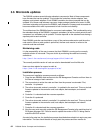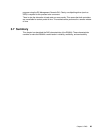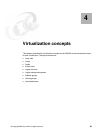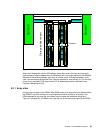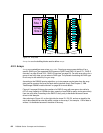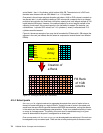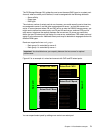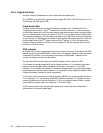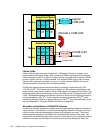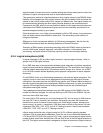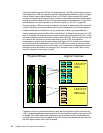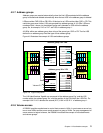
70 DS6000 Series: Concepts and Architecture
and a Model 1 has 1113 cylinders, which is about 0.94 GB. The extent size of a CKD rank
therefore was chosen to be one 3390 Model 1, or 1113 cylinders.
One extent is the minimum physical allocation unit when a LUN or CKD volume is created, as
we discuss later. It is still possible to define a CKD volume with a capacity that is an integral
multiple of one cylinder or a fixed block LUN with a capacity that is an integral multiple of 128
logical blocks (64K bytes). However, if the defined capacity is not an integral multiple of the
capacity of one extent, the unused capacity in the last extent is wasted. For instance, you
could define a 1 cylinder CKD volume, but 1113 cylinders (1 extent) is allocated and 1112
cylinders would be wasted.
Figure 4-4 shows an example of an array that is formatted for FB data with 1 GB extents (the
squares in the rank just indicate that the extent is composed of several blocks from different
DDMs).
Figure 4-4 Forming an FB rank with 1 GB extents
4.2.4 Extent pools
An extent pool is a logical construct to aggregate the extents from a set of ranks to form a
domain for extent allocation to a logical volume. Typically the set of ranks in the extent pool
would have the same RAID type and the same disk RPM characteristics, so that the extents
in the extent pool have homogeneous characteristics. There is no predefined affinity of ranks
or arrays to a storage server. The affinity of the rank (and it's associated array) to a given
server is determined at the point it is assigned to an extent pool.
One or more ranks
with the same extent type can be assigned to an extent pool. One rank can
be assigned to only one extent pool. There can be as many extent pools as there are ranks.
FB Rank
of 1GB
extents
Creation of
a Rank
D1 D7 D13 ...
D2 D8 D14 ...
D3 D9 D15 ...
D4 D10 D16 ...
D5 D11 P ...
D6 P D17 ...
P D12 D18 ...
RAID
Array
Spare
Data
Data
Data
Data
Data
Data
Parity
. . . .
. . . .
. . . .
. . . .
. . . .
. . . .
. . . .
. . . .
1GB 1GB 1GB 1GB



